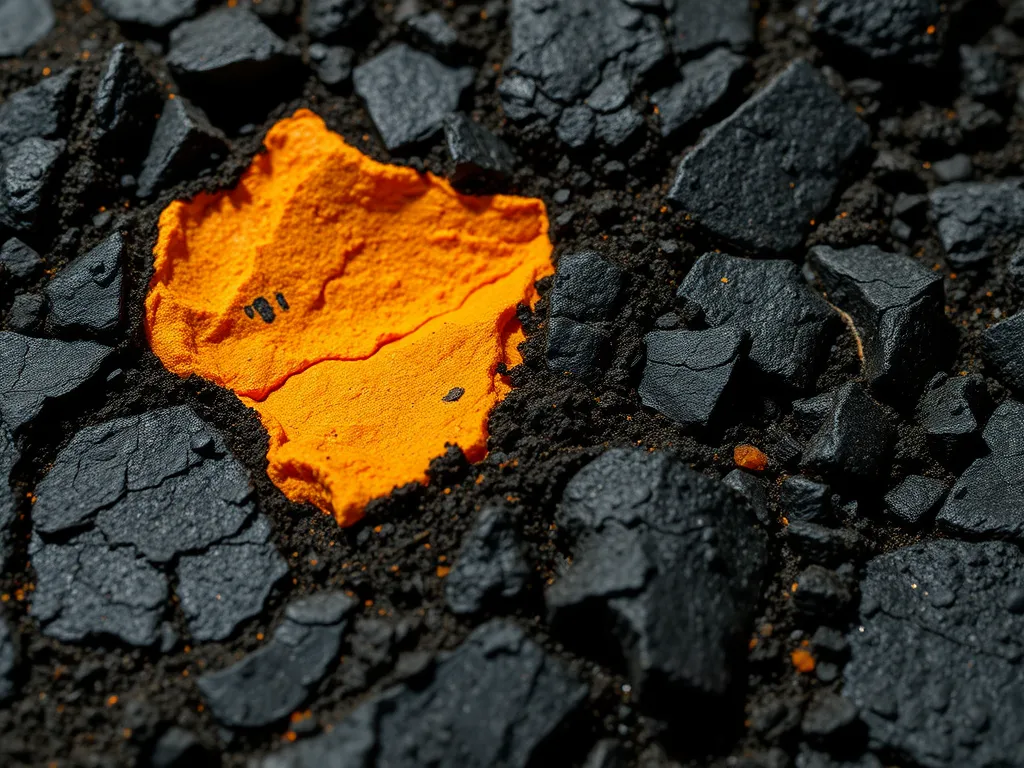Chemical Composition Of Bitumen in Asphalt
Published on: October 8, 2025 | Last Updated: April 14, 2025
Written By: George Voss
Bitumen’s chemical composition consists of 80-88% carbon, 8-11% hydrogen, and trace amounts of sulfur, nitrogen, and oxygen. This petroleum-based binder contains complex hydrocarbon molecules organized into asphaltenes (rigid structures) and maltenes (oily fluids). Unlike similar substances like coal tar, bitumen lacks polycyclic aromatic hydrocarbons (PAHs) above 0.1% concentration. Its molecular structure balances solid and liquid components, creating the sticky, waterproof properties vital for asphalt pavements.
This article breaks down bitumen’s chemistry layer by layer. Explore its core elements and molecular architecture. Learn how labs analyze components using gas chromatography and infrared spectroscopy. See how composition affects pavement durability in freezing winters or scorching summers. We’ll also examine environmental impacts of compounds like PAHs and methods for safer asphalt production.
Contents
Key Components Of Bitumen Chemical Structure
Bitumen’s chemical composition determines its performance in asphalt pavements. Composed primarily of hydrocarbons, it contains complex molecular structures that dictate flexibility, adhesion, and weather resistance.
Primary Elements in Bitumen Composition
Carbon (70-85%) and hydrogen (7-12%) dominate bitumen’s elemental makeup. Smaller amounts of sulfur (2-8%), oxygen (<5%), and nitrogen (<1%) create polar compounds influencing adhesion and aging.
Hydrocarbons: Asphaltenes, Maltenes, and Saturates
Three hydrocarbon groups form bitumen’s backbone:
- Asphaltenes: Dark, rigid molecules (10-20% of mass) providing stiffness and UV resistance
- Maltenes: Oily resins (40-60%) maintaining flexibility through temperature shifts
- Saturates: Waxy chains (5-15%) enhancing water resistance but reducing low-temperature performance
Aromatic Compounds and Their Role in Asphalt Binding
Aromatics (15-25%) feature ring-shaped molecules like benzene derivatives. These compounds dissolve asphaltenes, stabilize the colloidal system, and improve binder-aggregate adhesion through polar interactions.
Bitumen Molecular Composition
Molecular architecture varies by crude source and refining methods. Venezuelan bitumen typically has higher asphaltene content (18-22%) than Canadian sources (12-15%), affecting viscosity and aging rates.
Molecular Weight Distribution in Asphalt Binder
Bitumen molecules range from 300 to 2,000 Daltons. Gel Permeation Chromatography (GPC) reveals critical ratios:
- High-molecular-weight fractions (>1,000 Da) correlate with rutting resistance
- Low-weight fractions (<500 Da) influence thermal cracking at -20°C to 0°C
How Molecular Arrangement Affects Asphalt Durability
Clustered asphaltenes create a rigid matrix (good for high temps), while dispersed structures improve cold flexibility. PG grading tests confirm these effects – PG 64-22 binders show more branched molecules than PG 76-16 grades.
These structural insights set the stage for precise bitumen analysis methods used in quality assurance.
Analyzing Bitumen Composition
Breaking down the chemical composition of bitumen requires precise methods to evaluate its molecular makeup. These tests verify compliance with industry specifications while predicting performance in real-world conditions.
Common Methods for Bitumen Chemical Structure Analysis
Labs use advanced techniques to dissect bitumen’s complex chemistry. Results guide mix designs for roads, roofing, or waterproofing projects.
Chromatography and Spectroscopy Techniques
Thin-layer chromatography with flame ionization detection (TLC-FID) separates bitumen into four fractions: saturates, aromatics, resins, asphaltenes (SARA). Fourier-transform infrared spectroscopy (FTIR) identifies functional groups like carbonyls linked to oxidation. Nuclear magnetic resonance (NMR) maps hydrogen distribution in hydrocarbons, revealing structural details affecting viscosity.
Testing for Sulfur and Heavy Metal Content
X-ray fluorescence (XRF) quantifies sulfur levels, critical for meeting EPA limits under 0.5% in paving grades. Inductively coupled plasma mass spectrometry (ICP-MS) detects trace metals like nickel or vanadium from crude sources. High metal content may reduce binder elasticity, triggering premature rutting.
Bitumen Composition Values in Asphalt Production
Specifications focus on balancing key components to optimize pavement life. PG 64-22 binders, for example, require precise ratios of saturates to resins for thermal cracking resistance.
Standardized Metrics for Asphalt Quality Control
AASHTO M 320 sets thresholds for asphaltene content (5-25%) based on traffic loads. The colloidal instability index (CII), calculated using SARA data, predicts binder stability during temperature swings. High CII values (>1.5) signal risk of phase separation in storage tanks.
Next, we’ll explore how these chemical properties directly influence pavement behavior under stress.

Relationship Between Bitumen Chemistry and Asphalt Performance
Bitumen’s molecular structure directly dictates how asphalt behaves under traffic loads, temperature shifts, and weather. Let’s break down how its chemical composition affects key pavement properties.
Impact Of Chemical Properties on Asphalt Viscosity
Bitumen viscosity determines how easily asphalt mixes during production and compacts during paving. High asphaltene content (5-25% by weight) increases viscosity, creating stiffer binders ideal for high-traffic roads. Conversely, maltene-rich blends remain fluid at lower temperatures, aiding cold-weather paving. Modern PG (Performance Graded) binders use this chemistry to specify temperature ranges like PG 64-22, ensuring optimal viscosity for regional climates.
Role Of Bitumen Composition in Adhesion and Aging
Bitumen’s ability to bind aggregates relies on its polar aromatic compounds. These molecules form electrostatic bonds with stone surfaces. Over time, oxidation breaks these bonds, causing raveling. High-sulfur bitumen (up to 7% sulfur content) resists moisture damage better but may harden faster under UV exposure.
How Asphaltenes Influence Crack Resistance
- Asphaltenes (large, flat molecules) form a rigid network that resists deformation
- Optimal 15-18% asphaltene content balances stiffness without brittleness
- Low asphaltene bitumen (<10%) shows 40% higher rutting in ASTM D7870 tests
Maltenes and Temperature Sensitivity in Pavements
Maltenes (oily resins) act as plasticizers. Their ratio to asphaltenes determines:
- Low-temperature flexibility (critical for freeze-thaw cycles)
- Age-hardening rates (measured via Rolling Thin Film Oven tests)
- Self-healing potential through viscous flow
Pavements with maltene-rich binders show 30% less thermal cracking in -20°C climates but may rut 1.5x faster at 50°C.
These chemical relationships explain why composition analysis via methods like SARA (Saturates, Aromatics, Resins, Asphaltenes) fractionation is standard in Superpave mix designs. Up next: how bitumen’s molecular makeup impacts environmental safety during production and recycling.
Also See: Bitumen Viscosity Effects on Road Performance
Environmental Considerations Of Bitumen Composition
Bitumen’s complex chemical composition directly shapes its environmental footprint. From production to pavement recycling, molecular interactions influence ecological safety and long-term sustainability.
Polycyclic Aromatic Hydrocarbons (Pahs) in Asphalt
PAHs—carbon-rich compounds with fused benzene rings—occur naturally in bitumen. Typical asphalt contains 50-300 mg/kg of PAHs like benzo(a)pyrene and naphthalene. These molecules form during crude oil refining and remain chemically stable within asphalt binders.
Health and Safety Implications of PAHs
High-temperature asphalt applications (150-180°C) can release PAH vapors. Workers exposed to fresh asphalt fumes face potential risks, as certain PAHs are carcinogens. The EPA classifies benzo(a)pyrene as a Group 1 carcinogen, with occupational exposure limits set at 0.2 mg/m³ over 8 hours.
Mitigating Environmental Exposure During Application
Warm-mix asphalt technologies reduce paving temperatures by 20-40°C, cutting PAH emissions by 30-50%. Polymer-modified bitumen (PMB) also traps PAHs within the binder matrix. Agencies like Caltrans mandate asphalt plants to monitor airborne PAH levels using gas chromatography-mass spectrometry (GC-MS).
| Asphalt Type | PAH Concentration (mg/kg) | Emission Rate (μg/m³) |
|---|---|---|
| Hot-Mix | 280 | 45 |
| Warm-Mix | 165 | 22 |
| PMB | 90 | 8 |
Recycling Asphalt: Chemical Stability Of Reused Bitumen
Reclaimed asphalt pavement (RAP) retains 95-98% of its original bitumen composition. Aged bitumen shows increased asphaltene content (up to 25% vs. 18% in virgin binder), altering rheological properties. Rejuvenators like soybean oil restore maltene balance, enabling repeated recycling without structural compromise.
Breakdown Rates of Bitumen Components in Nature
Bitumen degrades at 0.1-0.3% per year under UV exposure. Microbes preferentially metabolize saturates (30% loss in 5 years) before attacking aromatics. Asphaltenes resist biodegradation, with only 5-8% breakdown over decades. This slow decay allows recycled asphalt to maintain 90% strength after 20 years in landfills.
Next, let’s address common questions about bitumen’s molecular structure and its practical effects on pavement performance.
FAQs: Bitumen Composition and Asphalt
What Are the Primary Ingredients in Bitumen?
The primary ingredients in bitumen are carbon, hydrogen, sulfur, nitrogen, and oxygen, with hydrocarbons like asphaltenes and maltenes making up the bulk of its structure. These ingredients contribute to the physical and chemical properties essential for asphalt performance.
How Does the Chemical Composition Of Black Bitumen Differ?
Black bitumen, commonly used in paving, can have variations in its chemical composition compared to lighter-colored types. Typically, black bitumen contains a higher concentration of asphaltenes, which enhance its viscosity and stiffness, contributing to its performance in heavy traffic conditions.
Tar Vs. Bitumen: Key Compositional Differences
Tar, derived from the destructive distillation of organic materials, contains a broader range of polycyclic aromatic hydrocarbons (PAHs) than bitumen, which is processed petroleum. Additionally, tar tends to be more viscous and contains different proportions of lighter aromatic hydrocarbons, influencing its application and environmental impact.
Is Bitumen Toxic to Humans or Ecosystems?
Bitumen itself is generally considered to pose low toxicity; however, certain components, such as PAHs, can be harmful under specific conditions. Prolonged exposure to fresh asphalt fumes can pose health risks, necessitating safety measures during its application. Environmentally, its slow degradation rate can lead to potential contamination if not managed properly.

Closing Thoughts
The chemical composition of bitumen is vital for the performance and durability of asphalt. This complex mixture, primarily made up of hydrocarbons, aromatic compounds, and maltenes, plays a significant role in paving applications. By understanding these components, we can better assess their impact on asphalt viscosity, adhesion, and aging processes.
Environmental factors, such as the presence of polycyclic aromatic hydrocarbons (PAHs), highlight the importance of health and safety considerations in asphalt usage. Recycling asphalt not only promotes sustainability but also underscores the chemical stability of reused bitumen, which is crucial in reducing waste.
For more insights and detailed information on bitumen and asphalt, visit Asphalt Calculator USA. Stay informed on the latest in asphalt technology and best practices for your projects!
Useful References for You:
- American Association of State Highway and Transportation Officials (AASHTO). (2008). Mechanistic-Empirical Pavement Design Guide (MEPDG). Washington, DC: AASHTO.
- Chemical and Physical Properties of Bitumen – Infinity Galaxy
- Chemical composition of bitumen components
- Relationships between Chemical Composition, Asphaltene …
- Chemical and Physical Composition of Bitumen


